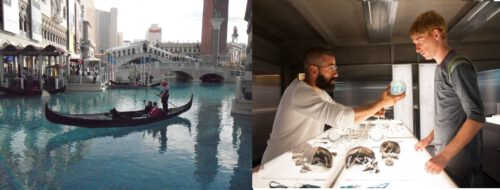media theory, science fiction theory,
future design research


-
Prominente: Groß und Klein
Die Amerikaner träumen groß. Die größten Hamburger. Die größten Hot Dogs. Zum Mond und Mars. Der Football Super Bowl und die Baseball World Series. Die größten Prominenten. Marilyn Monroe, Elvis Presley, Michael Jackson, Madonna. Sie waren groß. Sie waren die Stars. Das waren die Prominente im Zeitalter der Massenmedien. Sie waren von uns durch die…
-
The Third Order of Simulacra: Simulation and Hyperreality
The third order of simulacra in Baudrillard’s genealogy is also known as simulation: the system of objects, the consumer society, the system of models and series, simulated differences generated by “the code,” the post-World War II era of media, shopping mall architectures, and the American way of life.
-
The Controversy Around Baudrillard
Baudrillard is highly controversial as a thinker. Over the course of time, his work has had as many detractors as it has had defenders and enthusiasts. Some of Baudrillard’s critics absurdly even accused him of celebrating the postmodern media-cultural condition of simulacra and semiotic signs becoming increasingly autonomous and detached from the “referents” of which…
-
Early Baudrillard
The postmodern recombinant culture of cyber-commodities is a system of simulated differences or differences-in-sameness. The sign-object takes on its meaning in a system of marginal or minimal differences from other sign-objects, according to a code of hierarchical significations (Coke and Pepsi, McDonalds and Burger King, the subset of formula-generated episodes of a TV series or…
-
Methodology – Thirty Minute Statement at my Ph.D. Oral Defense
I will begin with some autobiographical remarks. I have a double educational background in the humanities and natural sciences. I studied the former at Cornell University and the latter at the Massachusetts Institute of Technology. Later in life, I worked for twenty years as a software developer. I had earlier studied literature and philosophy. My…
-
Blade Runner 2049: Android Liberation Between Old and New Informatic Power
Blade Runner 2049 is a brilliant sequel to the original Blade Runner. Thirty years after the events of the narrative of the first film, the police discover evidence of the secret that Rachael, who was a replicant or android, became pregnant and gave birth in a “natural” fertility process to a child. Rachael died while…
-
The “Science Fiction World” of Philip K. Dick’s Ubik
The novel Ubik is generally regarded as being Philip K. Dick’s masterpiece. In this major literary work of 1969, the struggle to occupy an “outside” relative to the “inside” of a cybernetic-economic-technological-virtual system is poignantly illustrated. It is a scenario where the “science fiction world” becomes everything, leaving the “safe confines” of a clearly defined…
-
Brain-Computer Interface
The digital-neurological or Brain-Computer Interface (BCI) is another key science fiction and “real” technology of the Fourth Industrial Revolution. BCIs can be interpreted as a “becoming cyborg” of humanity. One can distinguish between mainstream versus alternative/transformative designs and implementations of the user applications to be based on BCI – the command-and-control cyborg versus the feminist-theory…
-
Fiction, Power, and Codes in Hyper-Modernism
The most significant facet for my perspective is that, in hyper-modernism, the power and control exercised via narratives and fictions in the media-technological society now get implemented on much more detailed micro-levels via algorithmic-informatic codes and digital, virtual, and cybernetic technologies. We have become an informatic society. We are subjected to algorithms, data collection, Big…
-
Biosphere 2: The Artificial Paradise of Nature
Biosphere 2 is the enclosed artificial simulation of a natural environment in the Arizona desert which Baudrillard wrote about extensively in The Illusion of the End. Biosphere 2, according to Baudrillard, is the desperate project of a desperate humanity faced with its own extinction, the obsessive mania to create an artificial paradise of so-called na-…
-
The Truman Show: “The Last Thing That I Would Ever Do is Lie to You”
Truman Burbank – played by Jim Carrey – is under surveillance by television cameras twenty-four hours a day within the framework of a carefully choreographed Reality TV show that is watched by billions of voyeuristic viewers all over the world. Truman lives inside a vast Hollywood studio erected as an enclosed dome that is so…
-
Wendy Chun on Software Code
In her book Programmed Visions: Software and Memory (2011), Wendy Hui Kyong Chun develops her concept of “programmability” to argue that almost all social and economic institutions and procedures of life under capitalism are now shaped by software that pilots the unfolding of the future by intimately knowing data patterns and making extrapolations from the…
-
Claus Pias on First-Order Cybernetics
The complete transactions of the Macys Conferences on Cybernetics, held between 1946 and 1953, were recently (2015) edited by Claus Pias and published in English and German. Pias discusses the importance of first-order cybernetics in the post-Second World War history of ideas in his introductory essay called “The Age of Cybernetics,” which appears at the…
-
Bernhard Dotzler on Second-Order Cybernetics
Bernhard J. Dotzler is a prominent German media theorist who has written extensively about the philosophical, scientific, and literary historical backgrounds to the beginnings of the apparatus of the computer and first-order cybernetics. In his major three-volume work Diskurs und Medium, Dotzler considers discourse and medium as embodied knowledge or thinking, examining “archaeologically” the interconnections…
Got any book recommendations?